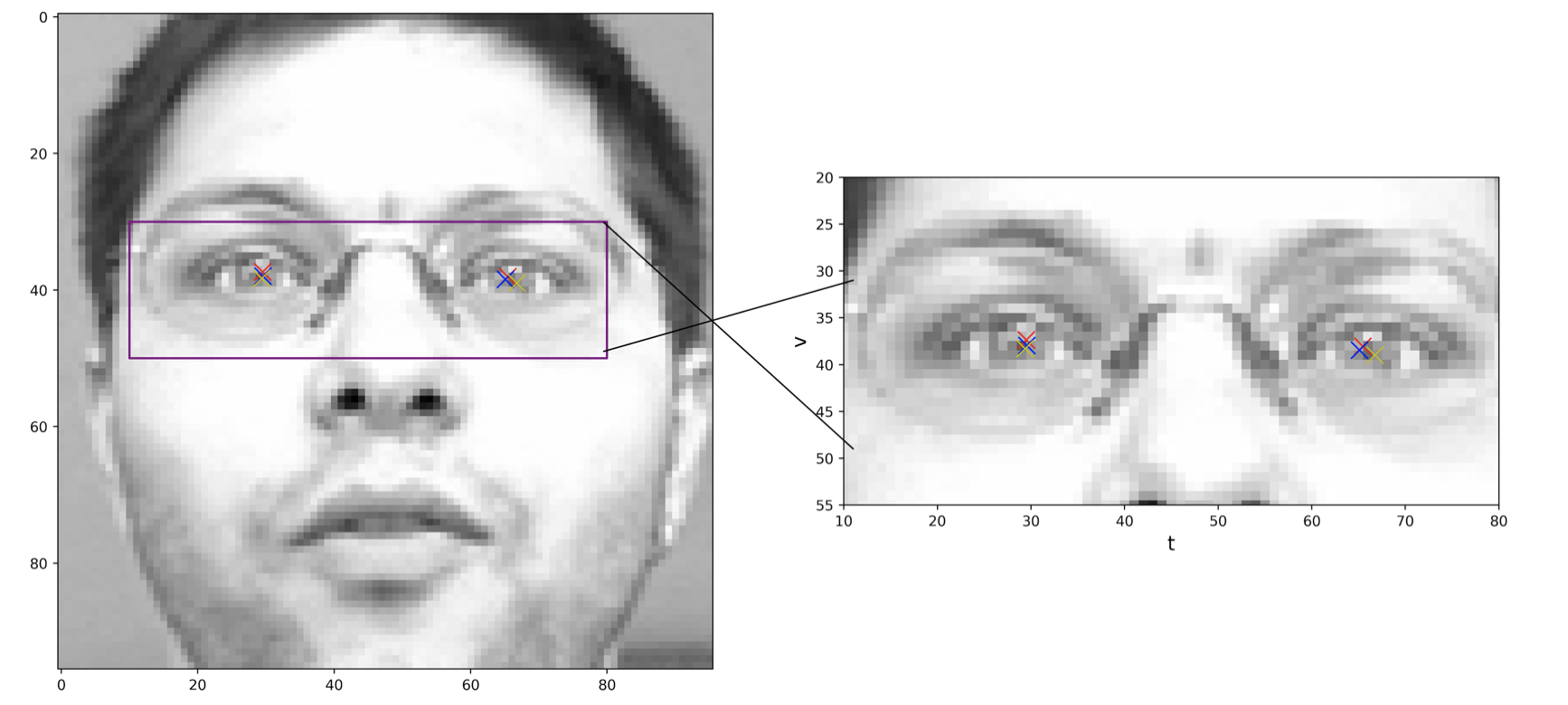王迪雅 Wang Diya 1701213099
王锦烽 Wang Jinfeng 1701213103
颜鹏 Yan Peng 1701213130
朱存正 Zhu Cunzheng 1701213170
Detecting facial keypoints is a very challenging problem. Facial features vary greatly from one individual to another, and even for a single individual, there is a large amount of variation due to 3D pose, size, position, viewing angle, and illumination conditions. Computer vision research has come a long way in addressing these difficulties, but there remain many opportunities for improvement. In this project, we are trying to predict keypoint positions on face images.
The original data is the all image pixel data. We use the original 96 X 96 dataset to build up 11 features. Each feature is specified by an (x, y) real-valued pair in the space of pixel indices.
| Feature | Description |
|---|---|
| SUM.L | Sum of all non-white points in the left eye area |
| SUM.R | Sum of all non-white points in the right eye area |
| Left.x.L | The x-coordinate of the leftmost black point in the left eye area |
| Left.x.R | The x-coordinate of the leftmost black point in the right eye area |
| Right.x.L | The x-coordinate of the rightmost black point in the left eye area |
| Right.x.R | The x-coordinate of the rightmost black point in the right eye area |
| Top.x.L | The x-coordinate of the uppermost black point in the left eye area |
| Top.x.R | The x-coordinate of the uppermost black point in the right eye area |
| Bottom.x.L | The x-coordinate of the downmost black point in the left eye area |
| Bottom.x.R | The x-coordinate of the downmost black point in the right eye area |
| Med.x.L | Median x-coordinate of all nonwhite points in the left eye area |
| Med.x.R | Median x-coordinate of all nonwhite points in the right eye area |
| Left.y.L | The y-coordinate of the leftmost black point in the left eye area |
| Left.y.R | The y-coordinate of the leftmost black point in the right eye area |
| Right.y.L | The y-coordinate of the rightmost black point in the left eye area |
| Right.y.R | The y-coordinate of the rightmost black point in the right eye area |
| Top.y.L | The y-coordinate of the uppermost black point in the left eye area |
| Top.y.R | The y-coordinate of the uppermost black point in the right eye area |
| Bottom.y.L | The y-coordinate of the downmost black point in the left eye area |
| Bottom.y.R | The y-coordinate of the downmost black point in the right eye area |
| Med.y.L | Median y-coordinate of all nonwhite points in the left eye area |
| Med.y.R | Median y-coordinate of all nonwhite points in the right eye area |
We find the dataset from Kaggle and use the image information of training dataset to build our model. (The dataset is so large that we just upload the compressed file.)
Step1: Building good training sets and data preprocessing.
(1)In all image pixel data, only the top 15% of the darkest point is retained. The remaining points are all turned to pure white.

(2)Set the border to remove noise, leave only the features of the five facial features, and turn all the other points into pure white.

(3)The image is divided into four parts along the midpoints of each side. Right upper part is used to analyze left eye and left upper part is used to analyze right eye.

First, we will focus on the area with only eye.
(1)If the area has less than or equal to three black points, the coordinates of the uppermost, downmost, leftmost, and rightmost points are directly extracted.
(2)If the area has more than three black points, the coordinates of the fourth uppermost, downmost, leftmost, and rightmost points are extracted.
(3)Then extract the sum of the pixels of all black points in the area.
(4)Calculate the median of the horizontal and vertical coordinates of all non-white points in the area for the left and right eyes.
Ultimately, we obtained the ordinates of the four boundary points of the eyes in the two regions, the median of the coordinate of the non-white dots and sum of all non-white points, which contains 22 features in total.
Step3: Using Decision Tree/Random Forest to predict facial keypoints.
Each predicted keypoint is specified by an (x, y) real-valued pair in the space of pixel indices. There are 2 keypoints, which represent the following elements of the face:
| Prediction | Description |
|---|---|
| left_eye_center_x | x-coordinate of the central point in the left eye |
| left_eye_center_y | y-coordinate of the central point in the left eye |
| right_eye_center_x | x-coordinate of the central point in the right eye |
| right_eye_center_y | x-coordinate of the central point in the right eye |
We will fix the problem of overfitting. Also, we will figure out which model is better to predict the central points of both eyes through mean standard error.
In this regression analysis, we find that Random Forest is a better model to predict the keypoints of both eyes through mean square error and its coefficient of determination is higher.
The results of Decision Tree:
| Prediction | MSE | coefficient of determination |
|---|---|---|
| left_eye_center_x | 4.131 | 0.061 |
| left_eye_center_y | 3.050 | 0.423 |
| right_eye_center_x | 3.729 | 0.162 |
| right_eye_center_y | 3.200 | 0.382 |
The results of Random Forest:
| Prediction | MSE | coefficient of determination |
|---|---|---|
| left_eye_center_x | 3.027 | 0.312 |
| left_eye_center_y | 1.977 | 0.626 |
| right_eye_center_x | 3.103 | 0.303 |
| right_eye_center_y | 2.464 | 0.524 |

The yellow points are the ture location. The red ones are the prediction of Decision Tree, while the blue ones are the prediction of Random Forest.